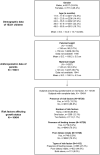Prevalence of undernutrition and associated factors in young children in Malaysia: A nationwide survey
- PMID: 36061396
- PMCID: PMC9433651
- DOI: 10.3389/fped.2022.913850
Prevalence of undernutrition and associated factors in young children in Malaysia: A nationwide survey
Abstract
Introduction: Undernutrition in young children is a significant public health problem globally. We determined the prevalence of and factors predisposing to stunting and underweight in children aged 1 to 5 years in Malaysia.
Materials and methods: Data were extracted from a cross-sectional nationwide campaign involving healthy children aged 1-5 years conducted over a 4-month period in 2019. We obtained information on demography, parental height and risk factors of undernutrition and anthropometric measurements (height and weight) of children enrolled. Age and sex-specific z-score for length/height-for-age (HAZ), weight-for-age (WAZ), body mass index (BMI) z-score (BAZ) and weight-for-height/length (WFH) z-score (WFHZ) were obtained using World Health Organization growth standards. The following definitions were used: (a) HAZ < -2 SD as stunted and -2 to -1 SD as at risk of stunting; (b) WFHZ < -3 SD as severe, -3 to < -2 SD as moderate wasting, and -2 to < +1 SD as normal; (c) WAZ -2 to -1 as at risk of underweight; (d) BAZ +1 to < +2 SD as at risk of and > +2 SD as overweight.
Results: Of the 15,331 children surveyed, prevalence of stunting and at risk of stunting were 16.1 and 20.0%, severe and moderate wasting were 4.0 and 6.1%, while 21.1% was at risk of underweight. Prevalence of at risk of and overweight 14.2 and 7.3%, respectively. One in fifth (25.0%) children had at least one form of undernutrition (stunting and/or underweight/wasting). Of the 1,412 (13.2%) children reported to have risk factors of undernutrition, 47.2% had feeding difficulties, 44.8% had poor dietary intake and 8.0% had both. Boys, paternal height < 156 cm and poor dietary intake were significantly associated with stunting and/or wasting. Compared with children with no risk factors, children with feeding difficulties were more likely to be wasted (AOR: 1.48, 95% CI: 1.18-1.85), and had at least one form of undernutrition (AOR: 1.45, 95% CI: 1.25-1.69).
Conclusions: In Malaysian children aged 1 to 5 years, dual burden of under- and overnutrition are common. Poor dietary intake and feeding difficulties were risk factors for undernutrition.
Keywords: at risk of undernutrition; prevalence; risk factors; stunting; undernutrition; wasting; young children.
Copyright © 2022 Lee, Jalaludin, Khoh, Kok, Nadarajaw, Soosai, Mukhtar, Fadzil, Anuar Zaini, Mohd-Taib, Rosly, Khoo and Cheang.
Conflict of interest statement
The authors declare that the research was conducted in the absence of any commercial or financial relationships that could be construed as a potential conflict of interest.
Figures
References
-
- United Nations Children's Fund (UNICEF) World Health Organization International International Bank for Reconstruction and Development/The World Bank . Levels and trends in child malnutrition: key findings of the 2021 edition of the joint child malnutrition estimates. Geneva: World Health Organization; (2021).
-
- Institute for Public Health (IPH) National National Institutes of Health Ministry Ministry of Health Malaysia . National Health and Morbidity Survey (NHMS) 2016: Maternal and Child Health. Vol. II: Findings. Kuala Lumpur: Ministry of Health Malaysia (2016). p. 272.
-
- Institute for Public Health (IPH) National National Institutes of Health Ministry Ministry of Health Malaysia . National Health and Morbidity Survey (NHMS) 2019: Vol. I: NCDs–Non-Communicable Diseases: Risk Factors and other Health Problems. Selangor: Ministry of Health Malaysia; (2020).
-
- World Health Organization. The Double Burden of Malnutrition: Policy Brief. (2017). Available online at: https://www.who.int/publications/i/item/WHO-NMH-NHD-17.3 (accessed April 21, 2021).
-
- International Food Policy Research Institute (IFPRI) . 2014 The coexistence of different forms of malnutrition is the “new normal”. in Global nutrition report 2014: Actions and accountability to accelerate the world's progress on nutrition. Chapter 4 Washington, D.C.: International Food Policy Research Institute (IFPRI) (1998). p. 22–8.
LinkOut - more resources
Full Text Sources


